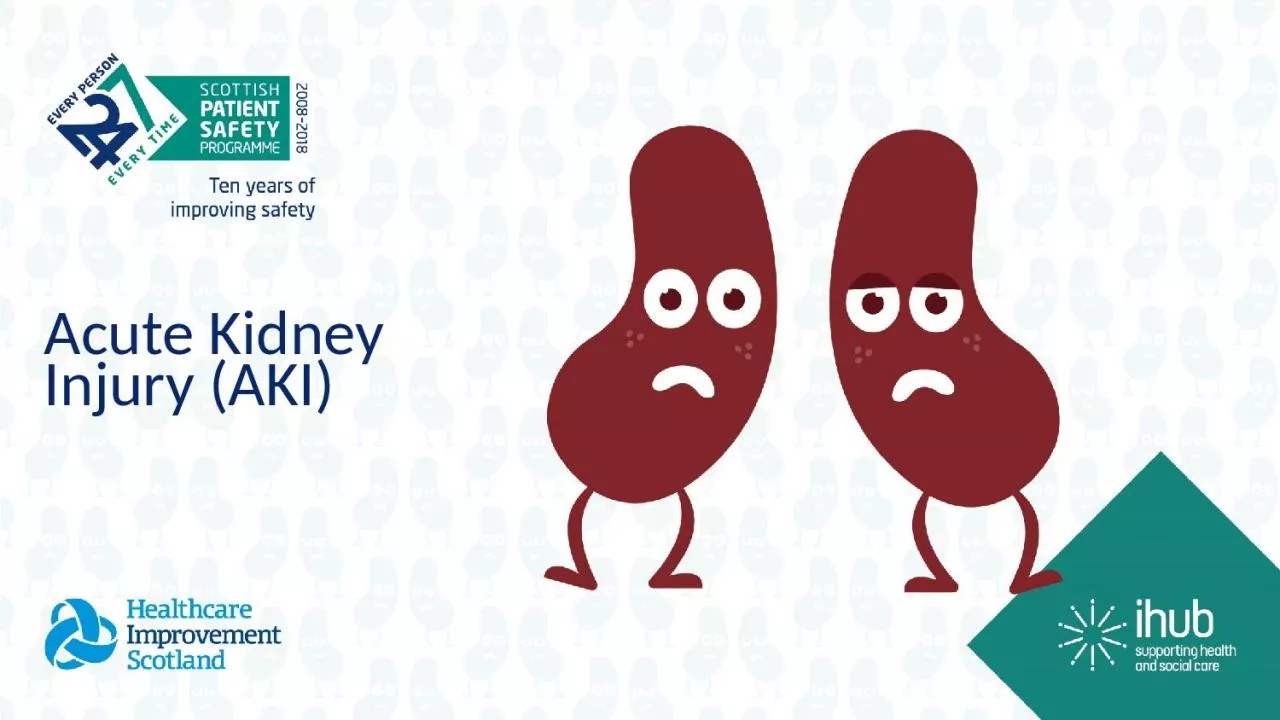

WHAT IS ACUTE KIDNEY INJURYAKI An abrupt decline in renal function defined by An increase in serum creatinine gt 265 umoll within 48hours or gt 19 times baseline known or presumed in the last ID: 918569
Download Presentation The PPT/PDF document "Acute Kidney Injury (AKI)" is the property of its rightful owner. Permission is granted to download and print the materials on this web site for personal, non-commercial use only, and to display it on your personal computer provided you do not modify the materials and that you retain all copyright notices contained in the materials. By downloading content from our website, you accept the terms of this agreement.
Slide1
Acute Kidney Injury (AKI)
Slide2WHAT IS ACUTE KIDNEY INJURY(AKI) ?
An abrupt
decline in renal
function defined by:An increase in serum creatinine > 26.5 umol/l within 48hours or > 1.9 times baseline known or presumed in the last 7 daysORA decrease in urine output to < 0.5ml / kg / hour for 6 hours or < 300mls in 12 hours
Slide3What is an adequate urine output?
160
kg/ 80
mls /hr.60kg/ 30mls/ hr.
0.5ml per kg per hour looks different for different people
Slide4Morbidity and mortality from AKI
AKI is associated with high mortality and adverse long-term outcomes and its prevalence in inpatients is believed to be rising. The NCEPOD report indicates that AKI risk factors are often not addressed and that a significant proportion of cases may be avoidable (NCEPOD 2009).
Mortality ranges from 10 – 80%
Renal Association (8th March 2011)
Slide5More than 20% of patients with an AKI will die rising to > 35% in those with AKI stage 3 (Think Kidneys)
Uncomplicated AKI has a 10% mortality rate
Slide6Patient Risk factors for AKI
AKI
Risk EventsOver 75Have co-morbities such asDiabetesHeart failureLiver diseasePeripheral vascular diseaseChronic
kidney disease
Cognitive impairment
Sepsis
High risk
medications
Hypotension
Hypovolaemia
Major
surgery
Contrast scans
Always treat
underlying cause of the AKI
Slide7Signs and symptoms of AKI
Evidence of
dehydration
Reduced urine outputChanges to urine colourNausea and vomitingThirstConfusion or drowsiness
Slide8What can we do to:prevent, recognise
and
respond to an
AKIPrevent Identify people at high risk of AKIImproved management of fluid prescription and fluid balanceReduce risk from medications RecogniseIT solutions – algorithm and e-alertsEarly recognition of deteriorating patients
Slide9Respond – Sepsis
, hypovolaemia, obstruction, urinalysis, toxins
SOU
T
Screen for sepsis or underlying cause.
Assess
and
document fluid status
Bladder scan and/or ultrasound
H
Ensure urinalysis performed
Stop/change high risk medications
Slide10High Risk Medications
Be aware of medicines that may be harmful for your patient and may make them feel worse when they are already unwell
ACE inhibitors e.g. Ramipril
Angiotensin receptor blockers e.g. Losartan
Metformin
NSAID’s
Diuretics
Gentamicin/
Vancomycin
Slide11Why urinalysis?
Simple , non-invasive easy to perform
Early signs of kidney damage can cause protein and small amounts of blood to be leaked into your urine
The earlier we spot and treat AKI the more chance we have of it not progressing
Slide12Healthy wee is 1 – 3
4 – 8 you MUST hydrate
Slide13Importance of fluid balance
Monitor fluid balance on a daily and cumulative basis
Daily weights
are also a good indicator of acute fluid loss or gainAccurately record fluid input and output
Slide14Summary
Accurate recording of intake
and
output Urinalysis – urine colour Discontinuing and / or avoiding certain potentially high risk medicinesMonitor NEWS and escalate as indicated for unwell patientsPrevention, early identification and early management
are key to preventing an AKI, reducing mortality and length of stay and improving our patient outcomes
Slide15NHS Tayside AKI video resource
https://www.youtube.com/watch?v=gW0pgXrIdgo
Slide16References
Adding insult to injury (2009) National confidential enquiry into patient outcome &
death.
http://www.ncepod.org.uk/2009aki.htmwww.renal.org/guidelineswww.thinkkidneys.nhs.uk/aki